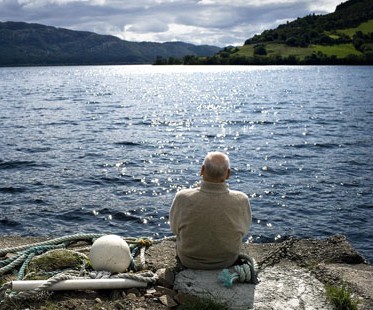Obituary

目擊者的證詞在法庭上倒是很好使,但是到了科學家那里卻不管用了。羅伯特·萊恩斯深知這一點,因為他自己就是一名科學家,還是名不錯的科學家。在研制雷達、聲納和超聲波裝置的過程中,他不僅做了必要的試驗,還提供了必需的實驗證據。但是當一個灰色發亮的圓丘突出于尼斯湖面之時,他就只是一個興奮的水怪目擊者了——興奮得喉嚨都哽住了,徑直朝那個方向跑去,眼睛緊貼著單筒望遠鏡觀瞧,后又換上雙筒望遠鏡。科學在這個時候不情愿地退居到了次席。
What he saw on that day in June 1972 he described as well as he could. It was a hump about 25 feet (8 metres) long, covered with rough dark-grey hide like an elephant’s back. The creature it belonged to ploughed against the current for a while, and then disappeared. It had presumably returned to its haunts in the murky, peaty depths of the lake. But Mr Rines’s life was upside down. The star lecturer in innovation at the Massachusetts Institute of Technology, the founder and president of the Academy of Applied Science, now had a myth on his hands. He determined to substantiate it with all the cash he could raise and all the expertise he could muster, because the alternative was ridicule, or worse. Galileo sometimes sprang to mind.
他那天看到的那一幕——即1972年6月的一天——他盡自己所能地描述了下來。那是一個大約25英尺(8米)長的圓形突出物,背部呈黑灰色、粗糙、好似象皮,逆著水流翻攪了一陣子之后,就消失了。假定的情形是它回到了它幽暗、滿是泥沼的老巢。但同時,萊恩斯的生活卻有了180度的大轉彎。這個麻省理工學院講授“創新”課程的明星講師,這個應用技術學院的創始人兼院長,現在有了一個縈繞心頭的謎題。他決心籌集所有能夠籌到的錢,集合所有能夠獲得的技術,來證實水怪的存在,因為說水怪不存在的說法便是荒謬的說法,要比說水怪存在更糟糕;他的心頭有時會浮起伽利略的形象。
He could have refused to believe his eyes, of course. Plenty of others suggested that he had really seen a tree trunk, a huge eel, a seal, an otter, an upturned boat or a ripple of wind on water. The creature had appeared at dusk, an illusory time of day. More pertinently, Mr Rines was already primed to see something in the loch. The year before he had taken part, half-sceptically, in experiments with underwater microphones that had picked up “bird-like chirps” in the deeps, and he had even had a perfume concocted to draw shy Nessie to his boat. His favourite reading then was Constance Whyte’s “More than a Legend”, which argued for the creature’s existence with testimony from witnesses she knew. With her, he agreed that this was “a really super ‘whodunit’”—a murder in which “the witnesses have seen the corpse, but cannot produce it.” Perhaps he could.
當然,他本可以拒絕相信眼前看到的一切。很多人都認為他看到的其實是別的東西,如一段樹干、一只巨大的鰻魚、一只海豹、一只水獺、一只翻了的小船,或是風在水面上掀起的一道波浪。而且這只生物是在傍晚時分出現的,這是一天當中容易引發錯覺的時候。并且萊恩斯已經預備自己會在湖上看到什么東西。前一年,他半帶著懷疑參加了一項科學實驗,用水中麥克風收集水下深處“鳥叫似的啾啾聲”,他甚至合成了一種香水來吸引害羞的“小尼斯”來到他的船邊。他那時最喜歡讀的書是康斯坦斯·懷特的《不只是傳說》,該書用她從目擊者那里得來的證詞來肯定水怪的存在。萊恩斯同意她的講法——這是“一本真正超級無敵的‘whodunit’式的偵探小說[這個類型的偵探小說只有到了結尾才知道誰是兇手。——譯者]”;在這場兇案中,“目擊者看到了被害人的尸體, 卻拿不出證據來。” 也許他能。
Instead he produced some famous photographs. They were taken in August 1972 by an underwater camera triggered by a sonar beam, and seemed to show a diamond-shaped flipper attached to a large underbelly. Everything was greenish and grainy, and the unretouched prints looked more like the lake-bed with a flurry of stirred-up sand. But they were published in Nature, and on the strength of them hearings were held in Parliament and a Latin name, Nessiteras rhombopteryx, was attached to the creature by Sir Peter Scott, a prominent naturalist. It was said to be a sort of plesiosaur, somehow stranded in the loch from 65m years ago. Sir Peter, better known for geese, painted a picture of a pair of them plumply swimming.
他在1972年8月用水下聲納攝影機拍攝了幾張很有名的照片,上面顯示的似乎是水怪巨大的下腹部,一個鉆石狀的菱形鰭狀肢附在其上。這些未經處理的圖片整體呈暗綠色,顆粒感很重,看起來更像是攪起一陣沙浪的湖底。盡管如此,《自然》雜志刊登了這些圖片,國會專門為此舉行了聽證會,著名的博物學家彼得·斯科特爵士還為它起了一個拉丁語學名:Nessiteras rhombopteryx(具有菱形鰭的尼斯巨獸)。據說這是蛇頸龍的一種,六千五百萬年前由于某種原因在此擱淺。彼得爵士還畫了一幅兩只水怪拖著胖墩墩的身子、在水里游泳的畫(和博物學比起來,彼得爵士更有名的是他畫鵝的畫)。
Very like a whale
非常像鯨魚
Mr Rines thought the Latin moniker had clinched it. But his evidence was still too sparse. During the war he had developed a radar that could detect aircraft at 200 miles through cloud; in 1985 his inventions in sonar helped to find the drowned Titanic in the North Atlantic; during the first Gulf war his technology guided Patriot missiles to their targets. But he was stumped by the gloomy profundities of Loch Ness. Scientist friends from MIT lent their expertise, at arm’s length. The most he heard, from sonar echoes in 1997, was very like a whale. The most he ever fished up—in 2008, on the last of almost 30 trips, when he supposed that the creature was dead and was looking for its carcass—was an old tyre cut about a bit, which could have looked quite humpish on the surface.
萊恩斯認為這個拉丁文學名已經抓住了水怪的特點,但是他能夠拿出的證據還是太少。二戰期間,他研制出一種可以透過云層探測200公里以外飛機的雷達;1985年,他的發明的聲納幫助找到了北大西洋的泰坦尼克沉船;第一次海灣戰爭中,他的專利技術引導愛國者導彈找到了目標。但是他卻在幽暗深邃的尼斯湖水面前受了阻。麻省理工學院的科學家朋友給他提供了專業技術,但只是點到為止。他聽到最清楚的一次是1997年聲納接受到的回聲,類似鯨叫;他從湖中釣出最大的戰利品是2008年的一只舊輪胎(那年,他幾乎去了30次,釣出輪胎的是最后一次,他當時認為水怪已死,于是尋找它的尸體),被切掉了一點,所以在水面上才呈現圓丘狀。
Even close family members, taken reverently into the “Nessie room” in his Boston apartment or instructed never to be without cameras on Scottish holidays, could not quite understand his obsession. But as well as being a scientist, Mr Rines was for 50 years a patent lawyer. His appetite for inventions went back to his childhood, when he had devised a fork and spoon that could fit into a penknife. He was pipped on that one, but died with around 100 patents to his name, most of them improvements to imaging things. A visit to his doctor for cataracts gave him his last invention, when he suggested a longer exposure of his eyeball to ultrasound radiation and found, on looking from his window that night, that the lights round Logan Airport were suddenly crystal clear.
他很近的親屬甚至也不大能理解他對此的癡迷,要知道萊恩斯曾經很鄭重地帶他們參觀過自己在波士頓公寓的“尼斯水怪展覽室”,在蘇格蘭度假時也告訴過他們千萬要記得帶照相機。除了是一名科學家,萊恩斯還作了50年的專利律師。他對于發明的喜好可以追溯到童年時代,他那時曾設計過一款能放進折疊刀的叉子和勺子,差一點就申請到專利。但當他去世時,名下卻有了100項左右的專利,大多都是對成像設備的改進。他最后一項發明來自一次看醫生、治療白內障的過程中,他建議醫生加長對眼球超聲輻射時間,結果當晚透過窗戶看外面時,他發現洛根機場周圍的燈光突然間變得水晶般的清澈。
He never saw clearly enough to find Nessie—except on that one day in 1972, when he had been too moved and excited to work the Super-8 camera that shook in his hand. But the founder of the Academy of Applied Science, and the patent lawyer, regularly recognised himself in the inventors, old and young, who came to see him. The streak of craziness; the thrill of the quest; the frequent difficulty of describing what their invention was, how it worked, what it was for; their vulnerability to ridicule, because what they had done or thought was new; and the need to protect that thought, as something interesting and precious in itself. Mr Rines’s generosity and openness to them was no more than he hoped for for himself, as he sat patiently in his waterproofs, waiting, beside a Scottish shore.
在尋找尼斯水怪的過程中,他卻從沒看清楚過——除了1972年的那一天,他由于過分的激動和興奮,都用不好他那臺Super-8型號的照相機了,手不停地抖動。但是這個實用技術學院的創始人,這個專利律師卻時常可以在拜訪他的年輕和年老的發明家那里看見自己的影子:近似瘋癲的性格;探索未知時的激動;描述新發明時常遇到的困難(諸如發明的東西怎么工作,發明的目地是什么);面對嘲笑時的脆弱(因為所做所想都是新東西);還有感覺需要保護新想法的心理(把新想法本身看作有趣的、要珍視的東西)。萊恩斯不會不包容這些性格,他對這些人是敞開的;但是他更希望那個坐在蘇格蘭的湖邊、穿著雨衣、靜靜等待的那個人——他自己,受到包容。











